
The Ancient Free and Accepted Masons Lodge 687, also known as the Independent Order of Odd Fellows J.R. Scruggs Lodge 372, is a building constructed in 1876 as a Masonic Hall. It is located in downtown Orangeville, Illinois, a small village in Stephenson County. The building, originally built by the local Masonic Lodge, was bought by the locally more numerous Independent Order of Oddfellows fraternal organization in 1893. The building has served all of Orangeville's fraternal organizations for more than 125 years, from the time it was built. The two-story, front gabled building has Italianate architecture elements. It had a rear wing added to it in 1903. By 2003, the first floor has been returned to use as a community center, holding dinner theatre and other community functions, much as the building had originally served the community until first floor space was rented out for commercial use in the late 19th century. The building was listed on the U.S. National Register of Historic Places in 2003. The building is the home of the Mighty Richmond Players Dinner Theatre (MRPDT) dinner theatre which seats 54 persons and has scheduled four different productions for the 2010 season. A $150,000 renovation of the building was recently completed. The building was listed on the National Register of Historic Places as AF and AM Lodge 687, Orangeville in 2003.

The former Odd Fellows Hall, located at 231 West Washington Row in Sandusky, Ohio, in the United States, is an historic building built in 1889 by members of the Independent Order of Odd Fellows. It is also known as the Independent Order of Odd Fellows Temple and Ogontz Lodge No. 66. On May 1, 2003, it was added to the National Register of Historic Places.

The Masonic Temple is a historic building located in Kingman, Arizona. The temple was built in 1939 for Kingman Masonic Lodge No. 22. Designed in the Moderne style, it was the second of two WPA Projects in Kingman. The temple is next door to the old post office.
Austin Building may refer to:
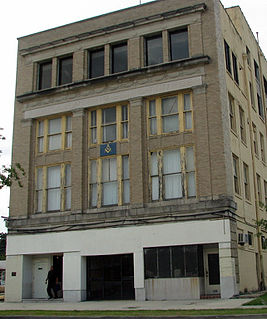
The Prince Hall Masonic Temple is a historic building located at 1335 North Boulevard in Baton Rouge, Louisiana.

The Masonic Temple is a historic Masonic temple in the village of Mechanicsburg, Ohio, United States. Built in the 1900s for a local Masonic lodge that had previously met in a succession of buildings owned by others, it is the last extant Mechanicsburg building constructed for a secret society, whether Masonic or otherwise, and it has been designated a historic site because of its well-preserved American Craftsman architecture.

The Wheatland Masonic Temple in Wheatland, California is a historic building constructed in 1898. The ground floor has been used as commercial space since its construction. Until 1948 the upper floor meeting rooms were used jointly by the Independent Order of Odd Fellows and the Freemasons. In 1948 the Masons bought out the Odd Fellows.

The Brewster Building is a historic commercial building and IOOF Hall located at 201 Fourth Street in Galt, California. It was built in 1882 and was listed on the National Register of Historic Places in 2000.

The Odd Fellows Temple in East Liverpool, Ohio, was built in 1907. It was listed on the National Register of Historic Places in 1985.
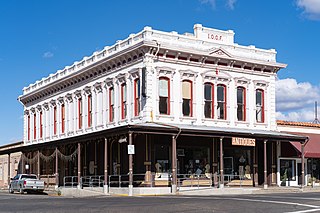
The Odd Fellows Building in Red Bluff, California was built during 1882–83. It was the fourth home of the I.O.O.F. Lodge #76, one of the oldest Odd Fellows groups in Northern California.

The Odd Fellows Hall, also known as Big Horn Odd Fellows Hall, is located in Big Horn, Wyoming, and was built in 1894. The hall was originally used by Big Horn's chapter of the Independent Order of Odd Fellows and was later used by the Odd Fellows' sister organization, the Rebekahs. The organizations hosted community events until the Odd Fellows merged with another chapter in 1949 and the Rebekahs disbanded in 1970; the groups mainly folded because they lacked the resources to maintain their building. The building features a false front, a common design feature in buildings in Western boom towns; it is one of three remaining historic buildings in Big Horn with a false front.

The Odd Fellows Hall is a historic building located at 516 Main St. in Salmon, Idaho. The building was constructed in 1874 as a meeting place for Salmon's chapter of the International Order of Odd Fellows. The wood frame building was designed in the Greek Revival style and features Ionic pilasters on its front face. A wooden front designed to resemble cast iron was added to the building in 1888. The Odd Fellows built a new meeting hall, the Salmon Odd Fellows Hall, in 1907. The original building is one of the few remaining fraternal halls from the 1800s in Idaho.
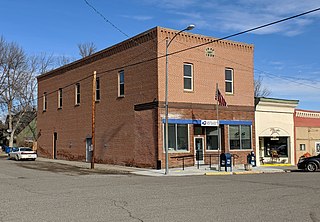
The IOOF Hall and Fromberg Co-operative Mercantile Building was built in 1906 at the west end of downtown Fromberg, Montana. It was the first brick building in Fromberg and served historically as a department store and as a meeting hall. It was listed on the National Register of Historic Places in 1993.
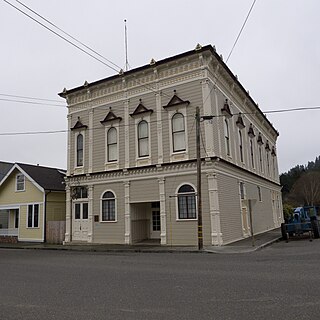
The Masonic Temple in Ferndale, California is located at 212 Francis Street, in an Eastlake-Stick style building built in 1891. The Masonic Hall is a contributing property in the Ferndale Main Street Historic District which was added on 10 January 1994 to the National Register of Historic Places. Ferndale Masonic Lodge F & A. M. #193 holds meetings in the building.

The Austin Cemetery, in Austin, Nevada, United States, is a 5-acre (2.0 ha) cemetery whose first known burials were in 1863. It consists of four cemetery sections: Masonic and Odd Fellows sections on the north of U.S. 50, and Calvary (Catholic) and "Citizens" sections on the south side. It was listed on the National Register of Historic Places in 2003. A fifth section, for Indians, next to the Citizen's section, is not included in the NRHP listing, due to owner issues.
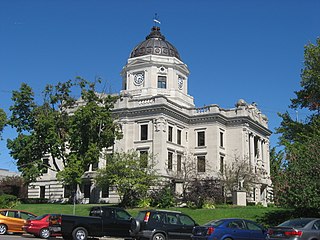
Courthouse Square Historic District is a national historic district located at Bloomington, Monroe County, Indiana. The district encompasses 57 contributing buildings in the central business district of Bloomington. It developed between about 1847 and 1936, and includes notable examples of Classical Revival, Beaux Arts and Italianate style architecture. Located in the district are the separately listed Bloomington City Hall, Monroe County Courthouse, Princess Theatre, and Wicks Building. Other notable buildings include the Federal Building, Masonic Temple, former Faulkner Hotel, Odd Fellows Building (1892), Allen Building (1907), First National Bank Building (1907), Knights of Pythias Building (1907), and Graham Hotel Building.

Lyric Theater, also known as Thespian Hall, is a historic theatre in Boonville, Cooper County, Missouri. It was built in 1855–1857, and is a two-story, rectangular Greek Revival–style brick building. The front facade features a portico with four unfluted Doric columns constructed of wedge-shaped brick. The building was enlarged in 1901. When originally constructed, the basement was used as reading room, the main floor was used as combined theater and lecture hall or auditorium, and the second floor housed the city hall, a Masonic lodge, and an Odd Fellows hall.

The Saratoga Masonic Hall is a two-story brick building in downtown Saratoga, Wyoming that houses Saratoga's Masonic lodge. Established in 1892, the lodge was the fourteenth to be established in Wyoming. After a time in rented space, the lodge bought the Couzens and Company Block in 1893, using the second floor for meetings and leasing the ground floor to storekeeper A. Johnson Dogget. From 1895 the ground floor was used as a school. The Masons allowed a variety of other organizations to use the building, including the Odd Fellows, Knights of Pythias, Pythian Sisters, Union Fraternal League, Modern Woodmen, Women of Woodcraft, Job's Daughters, the Republican Party and the Ku Klux Klan.
The Frankfort Commercial Historic District in Frankfort, Kentucky is a 24 acres (9.7 ha) historic district which was listed on the National Register of Historic Places in 1979. It included 86 contributing buildings and one contributing structure.


















